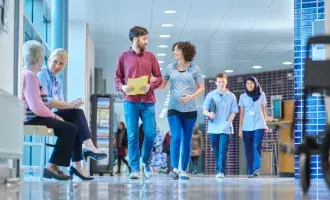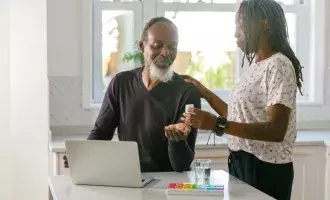People want to be able to contact their local council easily, quickly and on whatever channel suits them best. They don’t want to have to struggle with technology and then be made to wait around for a response.
So it’s vital that councils continue to build on the technological momentum that built up during the coronavirus pandemic, and place citizens – especially vulnerable ones – firmly at the centre of all their service delivery innovations.
That was the message from Capita Local Public Services’ Chris Melia, Director of Customer Experience, and Kate Fitzsimons, Director of Business Development, at a webinar held recently by the Society for innovation, technology and modernisation (Socitm). They joined Socitm Vice President Alison Hughes and Catherine Mills of the Good Things Foundation to discuss the next stage of local authorities’ modernisation of ICT service delivery to create better outcomes for communities.
Alison set the scene for the discussion by describing how her own local authority, Liverpool City Council, responded to the challenges posed by the pandemic, such as quickly transferring large numbers of employees to work from home and having to replace face-to-face services with online alternatives, by expanding and improving its digital capability.
A major innovation was to set up a cloud-based contact centre, which Alison described as a “risky, some might say career-defining, strategy” given the contact centre’s importance during the pandemic. It allowed the council to be more agile, improve its customer data, use a range of different channels to interact with customers, and provide lots of useful new features.
“I believe strongly that ICT is a key service which is underpinning so many things that are happening in local government, and my view is that we need to always focus on the core elements of that and how we leverage that and why that’s important,” she added.
Catherine is Head of Digital Social Inclusion at the Good Things Foundation, a social change charity that helps people to use digital technology to live better lives. She provided a very clear picture of why councils need to put citizens – especially vulnerable ones – at the heart of their digital transformation activities.
She said that, currently, 9 million people in the UK can’t use the internet without support and 7 million don’t have internet access at home. There’s a “very strong” connection between digital exclusion and poverty – people on low incomes are less likely to have digital skills than those on high incomes.
She shared data from the foundation’s Digital Nation research, which shows a clear “digital divide” in the UK between people who have full access to the internet and the ability to use it for a wide range of activities, from listening to music or watching films to applying for jobs or managing their bank account, and those who don’t. In the North East, for example 53% of the population is digitally excluded, compared to 35% of the population in the South East.
The digital divide has been made worse by the pandemic, Catherine said, with already-excluded people facing extra challenges such as reduced incomes that make it even harder to afford the internet. But with so many services moving online, people wanted to improve their digital skills.
“A lack of access leads to isolation and people now knowing where to turn,” she said.
The Good Things Foundation recommends three actions to close the digital divide:
- Making support for digital inclusion available and easily accessible in every village and town in the UK
- Creating a data poverty lab to build on local authorities’ responses to the pandemic and collaborate with the public and private sectors on “sustainable solutions” to end data poverty
- Implementing a digital strategy for all UK citizens, “leaving no one behind”.
Catherine added: “We need to make digital inclusion a social priority and we need to embed it into financial health and government public services. We need to look at things like the metrics and establish a better baseline, informed by the people, of what we need to live in a digital society.”
Taking both a citizen and a council perspective, Chris and Kate shared their insights and ideas about digital transformation and the importance of local authorities using their customer data more effectively than they did before the pandemic.
There has been a lot of change during the pandemic, Chris said, some of it accelerated. Councils need to maintain that momentum and continue to develop things they’ve done very quickly over the past year that have worked very well.
Citizens want to be able to contact councils 24 hours a day and there have been some good examples, both before and during the pandemic, of local authorities introducing technology to make that happen, from automated telephony to improved online journeys. “It’s definitely something we’re seeing through the work we do with organisations that they should ensure they maintain,” said Chris.
Citizens also want to be able to use a variety of channels to make contact, and it’s important that councils take that into account and adapt accordingly. It’s particularly important to ensure that vulnerable citizens don’t get left behind.
Chris described a workshop that he’d run for vulnerable adults to find out how they preferred to contact their local council. They all wanted to use channels such as WhatsApp and online chat, but they only had the option of using a website or filling in a form.
He said: “It’s all about making sure that, whatever technology we bring in, it’s designed around the customer if we’re expecting [them] to actually interact with [us] in the way that we’d like them to.”
He highlighted another issue, which was that citizens don’t want to be kept waiting on the phone for a long time when they interact with the council – they want to be able to talk to someone quickly, whether that’s remotely or in person. It was a “massive” challenge for local authorities to make that happen for the 9 million UK residents who don’t have access to the internet: “We need to be really clever and engaging with citizens about how they can use our services and how we can design them so we can cater for the people that just can’t get through using online services.”
This was in contrast to tech-savvy citizens who wanted to be able to use multi-channel customer platforms to get constant updates on their requests. Chris said he had started to see more organisations introduce platforms such as Amazon Connect more widely in response to this demand.
Citizens also wanted to have efficient conversations with councils, without being bounced around from department to department and having to give different people the same information. Chris said: “One contact or one call should be enough for informing the council on multiple things. So, again, how can we provide the technology to get that Holy Grail of ‘tell us once’? Most authorities are quite a way off that at the moment. Some progress has been made during the pandemic but there’s still lots of work to do.”
Councils needed to have a joined-up strategy so that citizens could contact them on different platforms and in different ways, depending on their enquiry or their personal preference, to ensure that they would receive the same great service.
Chris added that providing a great customer experience had become the main priority for many councils during the past year – he’d seen a “massive shift” away from cost efficiencies towards customer experience. “People are realising that, actually, without getting the customer experience right, [citizens] aren’t going to use the technology that they’ve implemented so they’re not going to see the efficiencies anyway.
“We need our services to be available to all customers on accessible channels so, clearly, there needs to be investment in technologies to provide different types of channels. We also need to look at ways that we can use customer data to get actionable insights that are going to drive change and make decision-making far easier.”
Kate outlined five themes that councils need to consider:
- Really understanding the baselines of the local authorities and the communities they’re serving, so they can capture and analyse data to track the benefit that people are enjoying from different services
- Recognising what time scales and speeds are achievable, carrying out a skills audit to make sure they can implement new technology and assessing the community’s openness to change
- Understanding citizens’ expectations and ensuring that they receive the best possible customer experience, continually learning from other local authorities’ experiences and successes
- Developing strong, productive partnerships with other organisations in the public and third sectors to share data and collectively use assets to deliver a much better outcome for citizens
- Taking an opportunity to collaborate with other organisations to fund technology projects, whether that’s sharing assets and facilities or coming together on digital inclusion programmes.
Kate concluded that these approaches would enable local authorities to make “a more fundamental kind of step change and build on the changes that have happened across an authority or region over the last 12 months”.







